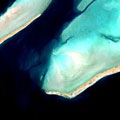The EOMAP aquatic remote sensing company, together with partners at the Remote Sensing Research Centre of Queensland University and the Great Barrier Reef Foundation, are developing new methods to monitor and detect coral bleaching events using Europe's Sentinel-2A satellite.
The EOMAP aquatic remote sensing company, together with partners at the Remote Sensing Research Centre of Queensland University and the Great Barrier Reef Foundation, are developing new methods to monitor and detect coral bleaching events using Europe's Sentinel-2A satellite.
The Great Barrier Reef is suffering dramatic levels of coral bleaching over large areas of the northern reefs.
In order to assess the extent of a bleaching event, scientists and managers often resort to surveys from aircraft, followed by targeted dive surveys. With the Reef being approximately the size of Italy, this is a costly and time-consuming procedure, particularly when repeat surveys are required.
Today, Sentinel-2A provides the required spatial and temporal resolution for detecting and monitoring coral bleaching (of a certain magnitude in area and duration) at Reef-wide scales.
